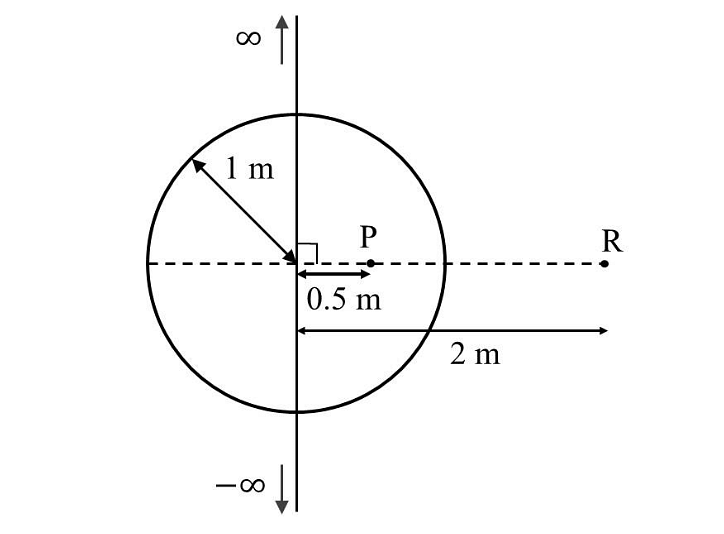Four equal charges $q$ each are placed at four corners of a square of side a each. Work done in carrying a charge $-q$ from its centre to infinity is
- zero
- $\frac{\sqrt{2}q}{\pi\varepsilon_{0}a}$
- $\frac{q^{2}}{2\pi\varepsilon_{0}a}$
- $\frac{\sqrt{2}q^{2}}{\pi\varepsilon_{0}a}$
The Correct Option is D
Solution and Explanation

$V =\frac{4 q}{4 \pi \varepsilon_{0}(a \sqrt{2}) / 2} $
$=\frac{ \sqrt{2}q}{\pi \varepsilon_0 a}$
$ \therefore W_{0 \infty} =-W_{\infty 0} $
$=-(-q) V$
$=\frac{\sqrt{2} q^{2}}{\pi \varepsilon_{0} a}$
Top Questions on electrostatic potential and capacitance
An electric charge \(10^{-6} \, \mu C\) is placed at the origin (0, 0) of an X-Y coordinate system. Two points P and Q are situated at \((\sqrt{3}, \sqrt{3}) \, \text{mm}\) and \((\sqrt{6}, 0) \, \text{mm}\) respectively. The potential difference between the points P and Q will be:
- JEE Main - 2024
- Physics
- electrostatic potential and capacitance
- An infinitely long thin wire, having a uniform charge density per unit length of \(5 nC/m,\) is passing through a spherical shell of radius \(1 m\), as shown in the figure. A \(10 nC\) charge is distributed uniformly over the spherical shell. If the configuration of the charges remains static, the magnitude of the potential difference between points P and R, in Volt, is ______. [Given: In SI units \(\frac{1}{ 4πϵ0} = 9 × 10^9 , ln \ 2 = 0.7\). Ignore the area pierced by the wire.]

- JEE Advanced - 2024
- Physics
- electrostatic potential and capacitance
- Two capacitors, of capacitance C, are connected in series. If one of them is filled with a dielectric substance K, what is the effective capacitance?
- BITSAT - 2023
- Physics
- electrostatic potential and capacitance
- A parallel plate capacitor with plate area A and plate separation d is filed with a dielectric material of dielectric constant K = 4. The thickness of the dielectric material is x, where \(x < d\).

Let C1 and C2 be the capacitance of the system for \(x=\frac{1}{3d}\) and \(x=\frac{2d}{3}\), respectively. If \(C_1 = 2μF\), the value of C2 is __________μF.- JEE Main - 2023
- Physics
- electrostatic potential and capacitance
- An electric dipole is placed as shown in the figure.

- NEET (UG) - 2023
- Physics
- electrostatic potential and capacitance
Questions Asked in VITEEE exam
- Two identical blocks A and B, each of mass 'm' resting on a smooth floor are connected by a light spring of natural length L and spring constant K, with the spring at its natural length. A third identical block 'C' (mass m) moving with a speed v along the line joining A and B collides with A. the maximum compression in the spring is
- VITEEE - 2023
- work, energy and power
- Assertion :
The binding energy of the nucleus increases with the increase in atomic number.
Reason :
Heavier elements have a greater number of non-radioactive isotopes than radioactive isotopes. - The half-life of radioactive radon is 3.8 days. The time at the end of which \(\frac{1}{20}th\) of the Radon sample will remain undecayed is (given log10e=0.4343)
- Which element has more electron gain enthalpy among chalcogen group?
- VITEEE - 2022
- sulphur
- Coin is tossed till heads is obtained what is expectation of no. of coin tosses
- VITEEE - 2022
- Random Variables
Concepts Used:
Electrostatic Potential and Capacitance
Electrostatic Potential
The potential of a point is defined as the work done per unit charge that results in bringing a charge from infinity to a certain point.
Some major things that we should know about electric potential:
- They are denoted by V and are a scalar quantity.
- It is measured in volts.
Capacitance
The ability of a capacitor of holding the energy in form of an electric charge is defined as capacitance. Similarly, we can also say that capacitance is the storing ability of capacitors, and the unit in which they are measured is “farads”.
Read More: Electrostatic Potential and Capacitance
The capacitor is in Series and in Parallel as defined below;
In Series
Both the Capacitors C1 and C2 can easily get connected in series. When the capacitors are connected in series then the total capacitance that is Ctotal is less than any one of the capacitor’s capacitance.
In Parallel
Both Capacitor C1 and C2 are connected in parallel. When the capacitors are connected parallelly then the total capacitance that is Ctotal is any one of the capacitor’s capacitance.



